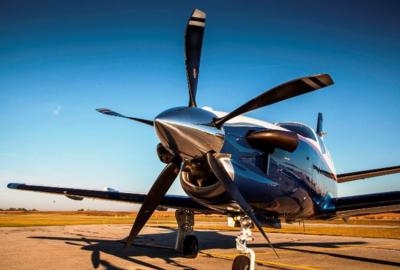Wed, Feb 26, 2014
Deliveries Set To Begin 'Shortly'
The FAA has granted an STC to Hartzell Propeller Inc. for the company’s advanced swept airfoil structural composite five-blade propeller to be installed on TBM 700/850 aircraft. Hartzell already has taken orders for the advanced propellers and deliveries to TBM owners are expected to begin shortly.

“Our new propeller design for the TBM turboprop results in faster takeoff acceleration, higher cruise speeds and better climb, along with less noise,” said Hartzell Propeller President Joe Brown.
"Carbon composite, due to its incredible strength and light weight, allows Hartzell’s design group the freedom to optimize blade chord thickness and sweep while still achieving maximum strength. That’s the key: thin, light and strong, leading to unmatched performance,” he added. “The strong structural composite construction of these carbon fiber blades and their sleek aerodynamic design boosts the TBM’s already impressive performance to an even higher level.”
With the new Hartzell propeller, the TBM’s takeoff acceleration from zero to 90 knots is 10 percent faster than with any other available propeller. Hartzell’s new propeller also provides for a couple hundred-feet-per-minute faster climb rate. Cruise is two knots faster than the Hartzell four-blade metal prop, and a full five knots faster than a less-advanced five-blade wood-based propeller option. The new Hartzell five-blade prop is also significantly quieter in the cabin and in the pattern.
Hartzell’s proprietary resin-injected carbon fiber blades are five to 10 times stronger than beech wood and spruce construction. The thinner airfoil, which is possible due to carbon fiber’s greater strength, makes the improved TBM performance possible.
The new five-blade design features a state-of-the-art composite wedge retention into its stainless steel alloy shank rather than the more rudimentary aluminum and lag screw construction used in lower performing propellers. Hartzell incorporates an innovative nickel erosion mesh and field replaceable nickel-cobalt erosion shield to prevent foreign object damage.
Hartzell received FAA and European Aviation Safety Agency (EASA) Type Certificate (TC) approval for the propeller in 2013. Hartzell offers the new prop with a “Plus 3” warranty, which covers the propeller for a full three years or 1,000 hours and a 3,600-hour/six-year TBO (Time Between Overhaul). The new propeller is available directly through Hartzell’s Top Prop conversion program.
(Image provided by Hartzell Propellers)
More News
Convective SIGMET A weather advisory concerning convective weather significant to the safety of all aircraft. Convective SIGMETs are issued for tornadoes, lines of thunderstorms, e>[...]
Aero Linx: United Flying Octogenarians WELCOME to a most extraordinary group of aviators, the United Flying Octogenarians (UFO). Founded in 1982 with just a handful of pilots, we h>[...]
Pilot’s Decision To Attempt Takeoff With Frost Covering The Airplane’s Wings Analysis: The pilot of the light sport airplane was preparing to depart for a cross-country>[...]
“We’ve paid for the cable line’s repair for the customer and have apologized for the inconvenience this caused them...” Source: Some followup info from an A>[...]
Coupled Approach An instrument approach performed by the aircraft autopilot, and/or visually depicted on the flight director, which is receiving position information and/or steerin>[...]
 ANN's Daily Aero-Term (12.01.25): Convective SIGMET
ANN's Daily Aero-Term (12.01.25): Convective SIGMET ANN's Daily Aero-Linx (12.01.25)
ANN's Daily Aero-Linx (12.01.25) NTSB Final Report: Remos Aircraft GmbH Remos GX
NTSB Final Report: Remos Aircraft GmbH Remos GX Aero-News: Quote of the Day (12.02.25)
Aero-News: Quote of the Day (12.02.25) ANN's Daily Aero-Term (12.02.25): Coupled Approach
ANN's Daily Aero-Term (12.02.25): Coupled Approach



